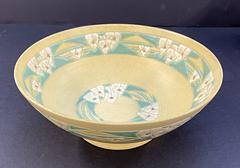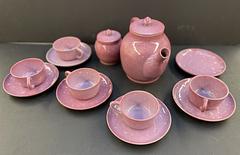Overbeck Pottery
| male | |
|
Life city:
Cambridge City, IN |
|
|
Work city:
Cambridge City, IN |
|
| Styles: Crafts Paintings Sculpture |
|
Drop us a note on your art or call the gallery (317) 253-5910.
Fine Estate is seeking pottery and paintings by the Overbeck sisters. If you have pieces you are considering selling, please contact us. The Overbeck Pottery studio was founded by four sisters, in Cambridge City, Indiana in 1911. The Overbecks, Margaret, Mary, Hannah, and Elizabeth, were known for their high quality decorative arts, and unlike traditional pottery manufacturers, did all of the work themselves from a recipe that went to the grave with the last surviving sister, Mary. They made their products in a home workshop, designed and decorated in a room off their dining room and fired in an outbuilding on their property. Hannah is credited as being the chief designer for several decades until her death in 1931 at age 61, an influence that led to large decorated pieces with highly colored patterns, uncluttered, and incised lines based on nature. Of her it was said she frequently could be seen with her sketch pad doing preparatory designs in pencil and watercolor. Her biggest inspiration was her family's property with flowers and vegetable gardens. Margaret was the second oldest of the sisters. Also an art student, she suffered injuries in a car crash in Chicago and returned home to Cambridge City where she founded the pottery studio with her sisters. She died the same year the studio was founded. Mary studied at Indiana Normal School, Terre Haute, IN. She was well know for designing bookplates, and all her career painted in oils and watercolors. Mary Frances created her pottery using the coil method. She contributed many designs and later, after her sisters died, worked alone and developed the figurines which were successful for the studio. Elizabeth was the only sister proficient at the potter's wheel. Although much of her work was constructed by hand, she was expert at mixing and firing glazes. She was especially noted for her 'hyancinth' coloration, which looked like a ripe raspberry with shadings of lavendar. After Elizabeth's death, her sister, Mary, carried on for another twenty years, though Mary did whimsical animals instead of the large decorative pieces, thus somewhat ending the years of the sister's best and most collectible works. Source: Judith Vale Newton and Carol Ann Weiss, Skirting the Issue The Magazine Antiques, July 2005
Can you tell us more about the life or art of Overbeck Pottery? Please contact us if you can add to our biography.










